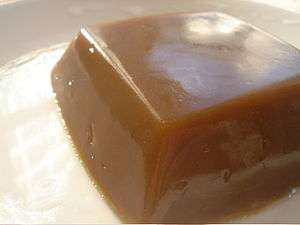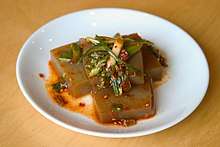Dotori-muk
 | |
| Alternative names | Acorn jelly |
|---|---|
| Type | Muk |
| Place of origin | Korea |
| Main ingredients | Acorn |
| Korean name | |
| Hangul | 도토리묵 |
|---|---|
| Revised Romanization | dotori-muk |
| McCune–Reischauer | tot'ori-muk |
| IPA | [to.tʰo.ɾi.muk̚] |
Dotori-muk[1] (도토리묵) or acorn jelly[1] is a Korean food which is a jelly made from acorn starch. Although "muk" means "jelly", when used without qualifiers, it usually refers to dotorimuk. The practice of making dotorimuk originated in mountainous areas of ancient Korea, when abundant oak trees produced enough acorns each autumn to become a viable source of food.
Production
Despite being a rich source of starch and proteins, acorns contain large amounts of tannins and other polyphenols, which prevent the human body from digesting them properly. Harvested acorns must be properly leached of the tannins prior to consumption.[2]
Acorns are either collected directly from the ground or knocked off the tree branches. The acorns are opened and their innards ground into a fine orange-brown paste. The paste is then stirred into vats of water and the acorns' fiber is separated from the starch through sieving and settling.[3] The starch-water mixture is collected and allowed to sit so that the tannins in the starch diffuse into the water, which is changed several times. The overall soaking time depends on the amount of tannins in the paste.
The now-tannin-free starch-water suspension should have an off-white colour. This starch is allowed to completely settle at the bottom of the vat, the water drained away and the paste collected in trays to dry. The dried starch cake is then pulverized and packaged for sale. Dotorimuk is also commercially available in powdered form, which must be mixed with water, boiled until pudding-like in consistency, then set in a flat dish.
Serving
Like other muk, dotorimuk is most commonly eaten in the form of dotorimuk muchim (도토리묵무침), a side dish in which small chunks of dotorimuk are seasoned and mixed with other ingredients such as slivered carrots and scallions, garlic, soy sauce, sesame oil, red chili pepper powder, and sesame seeds.
Muk-mari (묵말이) is also famous. As Muk-town was formed in Daejeon as part of a farm side business since the 1980s, Muk Cooking made by a woman started attracting people's attention. In particular, Muk-mari is made of salted seaweed (chopped seaweed powder) with its rich texture and is made of dried acorn.
 Dotori-muk-muchim (acorn jelly salad)
Dotori-muk-muchim (acorn jelly salad)
See also
- Nokdumuk - made from mung beans
- Hwangpomuk - a yellow-colored jelly made from mung beans
- Memilmuk - made from buckwheat
- Konjac - a Japanese jelly
References
- 1 2 (in Korean) "주요 한식명(200개) 로마자 표기 및 번역(영, 중, 일) 표준안" [Standardized Romanizations and Translations (English, Chinese, and Japanese) of (200) Major Korean Dishes] (PDF). National Institute of Korean Language. 2014-07-30. Retrieved 2017-02-19. Lay summary.
- ↑ Bainbridge, D. A. (November 12–14, 1986), Use of acorns for food in California: past, present and future, San Luis Obispo, CA.: Symposium on Multiple-use Management of California’s Hardwoods
- ↑ Pemberton, Robert W.; Lee, Nam Sook (1996), "Wild food plants in South Korea; market presence, new crops, and exports to the United States", Journal of Economic Botany, New York: Springer, 50 (1): 57–70
External links
| Wikimedia Commons has media related to Dotori-muk. |
- Muk page
- "Dotorimuk muchim recipe". Visitkorea :The Official Korea Tourism Guide Site. Korea Tourism Organization. Archived from the original on 2007-08-14. Retrieved 2007-01-19. External link in
|work=(help) - Seasoned Acorn Jelly (Dotori Muk Muchim) recipe
- Blog showing the commercial process for grinding, detoxifying, straining starch to make dotorimuk
- Blog showing the process at home for grinding, detoxifying, straining starch to make dotorimuk
- Another blog showing the process at home for grinding, detoxifying, straining starch to make dotorimuk
- Blog showing cleaned acorn starch being dried
- Grocery Ninja: Eating Acorn Jelly the Unorthodox Way